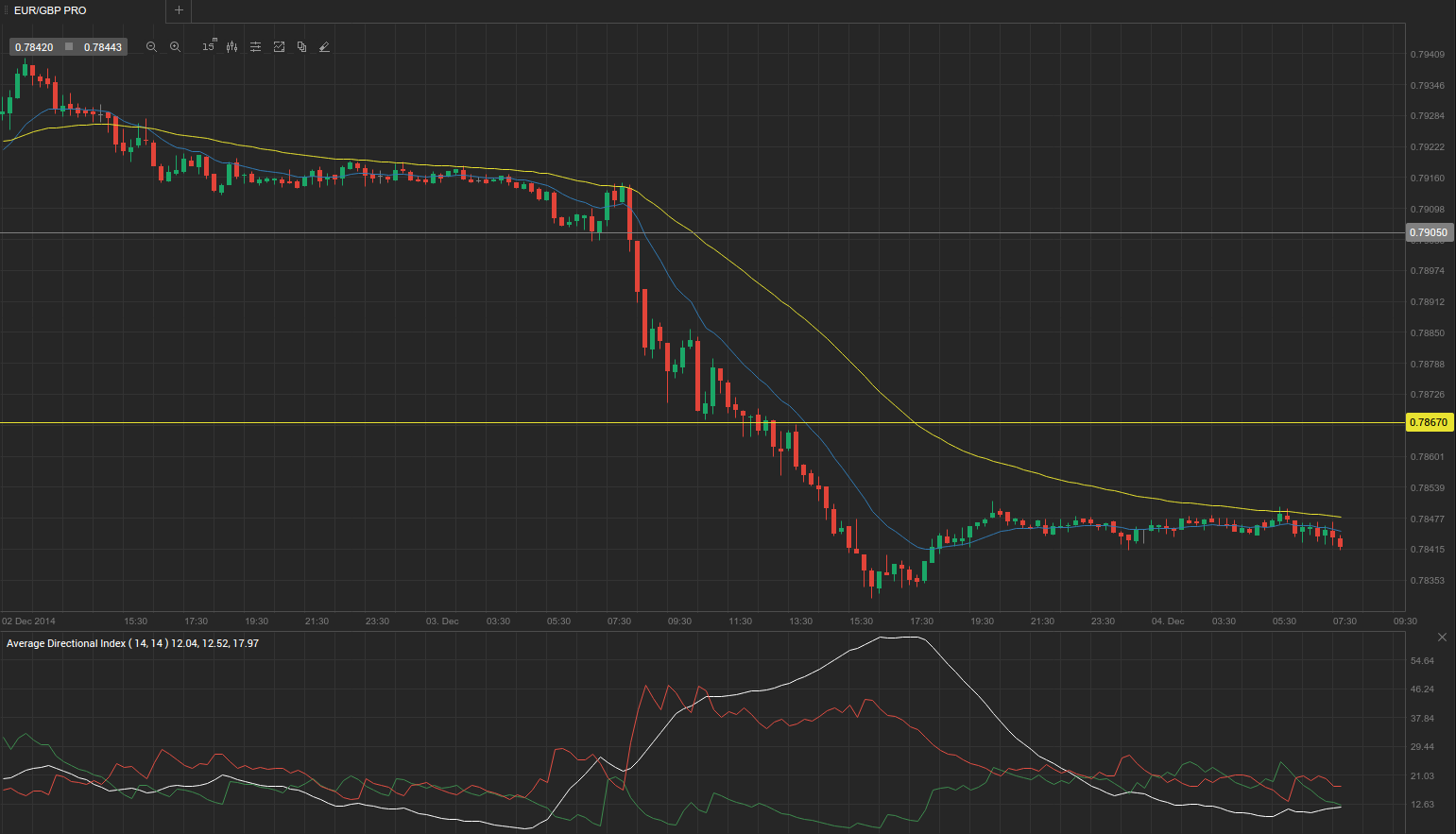 Yesterday’s trade saw EUR/GBP within the range of 0.7923-0.7830. The pair closed at 0.7849, losing 0.90% on a daily basis.
Yesterday’s trade saw EUR/GBP within the range of 0.7923-0.7830. The pair closed at 0.7849, losing 0.90% on a daily basis.
At 7:49 GMT today EUR/GBP was down 0.06% for the day to trade at 0.7844. The pair held in a daily range of 0.7842 – 0.7852.
Fundamental view
Eurozone
Unemployment in France rose to 10.4% in the third quarter, the National Institute of Statistics and Economic Studies (Insee) reported at 6:30 GMT. Analysts had projected a jump to 10.3% from a downward-revised 10.1% in the preceding three-month period.
At 12:45 GMT the European Central Bank (ECB) is to announce its decision in regard to borrowing costs. The median estimate by experts suggests that the central bank will probably maintain its benchmark interest rate at the record low level of 0.05% at the policy meeting today. The bank last reduced the refinancing rate by 0.1% to the current 0.05% at the September 4th meeting. This has been the fourth time this year, when the ECB cut its benchmark.
At its meeting on November 6th the central bank kept the marginal lending facility intact at 0.30% and the deposit facility at -0.20%.
Extracts from the Introductory statement to the press conference offered by ECB President Mario Draghi showed: ”Following up on the decisions of 2 October 2014, we last month started purchasing covered bonds under our new programme. We will also soon start to purchase asset-backed securities. The programmes will last for at least two years. Together with the series of targeted longer-term refinancing operations to be conducted until June 2016, these asset purchases will have a sizeable impact on our balance sheet, which is expected to move towards the dimensions it had at the beginning of 2012.”
With these measures the bank aims to enhance the function of the monetary policy transmission mechanism, to support financing conditions and to ease the provision of bank funding to the real economy.
At the most recent press conference Draghi also noted: ”With the measures that have been put in place, monetary policy has responded to the outlook for low inflation, a weakening growth momentum and continued subdued monetary and credit dynamics. Our accommodative monetary policy stance will underpin the firm anchoring of medium to long-term inflation expectations.”
The ECB president again stressed on the probability of taking even more drastic measures in order to stimulate consumer demand and, respectively, inflation. “Looking ahead, and taking into account new information and analysis, the Governing Council will closely monitor and continuously assess the appropriateness of its monetary policy stance. Should it become necessary to further address risks of too prolonged a period of low inflation, the Governing Council is unanimous in its commitment to using additional unconventional instruments within its mandate.”
“The risks surrounding the economic outlook for the euro area continue to be on the downside. In particular, the weakening in the euro area’s growth momentum, alongside heightened geopolitical risks, could dampen confidence and, in particular, private investment.”
Stalling business activity
On December 1st Markit Economics reported that manufacturing activity in Germany contracted last month, as it did in September also, with the respective manufacturing PMI falling to 49.5, while two days later it became clear that activity growth in the sector of services in Euro zones number one economy remained unchanged. Additionally, the final manufacturing PMI regarding the whole Euro region slowed down to 50.1 in November, or the lowest reading since June 2013, with the sub-gauge of new orders marking the most considerable drop in 19 months, regardless of the fact business entities significantly lowered their prices. The final services PMI in the region also demonstrated a slowdown to 51.1 in November from 52.3 in the prior month.
Alongside slowing activity, the Governing Council of the bank will need to take into consideration plummeting prices of crude oil and their effect on inflationary expectations. Analysts at UBS stated that deflationary processes, resulting from falling oil prices may force the central bank to expand its monetary stimulus measures, or meaning the inclusion of corporate and government bonds in the program. However, these experts do not expect this step to be taken at todays meeting. They point the policy meetings on January 22nd or March 5th as more probable.
ECB policy makers aim to keep prices in the region stable, while stability is defined as a year-on-year increase in the Harmonized Index of Consumer Prices (HICP) for the Eurozone of below, but close to 2%.
Short-term interest rates are of utmost importance for the valuation of national currencies. In case the European Central Bank is dovish about inflationary pressure and overall economic activity in the Euro area and, thus, either puts interest rates on hold, or reduces them further, this will usually cause a bearish impact on the common currency.
The interest rate decision is to be followed by the press conference with ECB President Mario Draghi, during which volatility of euro crosses is usually high. In case Draghi offers a more hawkish tone, the euro will usually receive support, while a more dovish tone will have a bearish effect on the currency. The press conference is scheduled at 13:30 GMT.
United Kingdom
At 12:00 GMT Bank of England is to announce its decision on monetary policy. The benchmark interest rate (repo rate) will probably be left unchanged at the record low level of 0.50%. The rate has been at that level since BoEs policy meeting on March 5th 2009. The repo rate applies to open market operations of the central bank with other banks, building societies, securities firms etc. Short-term interest rates are of utmost importance for the valuation of national currencies. Maintaining or reducing the repo rate usually leads to a sell-off in the national currency.
At the same time, the pace of BoE’s monetary stimulus will probably be left without change as well, at GBP 375 billion. The asset-purchasing programme, financed by the issuance of central bank reserves was started on March 5th 2009, while the scale of this programme was increased by GBP 50 billion to the current GBP 375 billion on July 5th 2012. The central bank issues new money in order to purchase gilts from private investors, such as pension funds and insurance companies. In case the scale of monetary stimulus is increased (in order to further spur economic growth), this will usually devalue the local currency.
Bank of England kept its growth forecast of 3.5% in 2014, but revised down by 0.2% its projections for 2015 and 2016 to growth of 2.9% and 2.6%, respectively. Extracts from the banks Inflation Report, released in November, stated: ”There is a significant probability that inflation could temporarily fall below 1% in the near term. Inflation then rises back to the target by the end of the forecast period as external pressures fade and growth in unit labour costs gradually picks up. There are significant risks either side of this inflation projection.”
“The Committee sets monetary policy to meet the 2% target in the medium term and in a way that helps to sustain growth and employment. The Committee gave guidance in its February Report on how it would seek to achieve the inflation target over the policy horizon. At its November meeting, the Committee noted that the central message of that guidance remained relevant: given the likely persistence of the headwinds weighing on the economy, when Bank Rate did begin to rise, it was expected to do so only gradually and to remain below average historical levels for some time to come. The actual path for monetary policy would remain dependent on economic conditions. In other words, the Committee’s guidance on the likely pace and extent of interest rate rises was an expectation, not a promise.”
The report hinted that borrowing costs may be raised at a later moment than anticipated. According to expectations, the central bank may introduce the first rate hike in almost six years in the spring of 2015, after parliamentary election in May.
Pivot points
According to Binary Tribune’s daily analysis, the central pivot point for the pair is at 0.7867. In case EUR/GBP manages to breach the first resistance level at 0.7905, it will probably continue up to test 0.7960. In case the second key resistance is broken, the pair will probably attempt to advance to 0.7998.
If EUR/GBP manages to breach the first key support at 0.7812, it will probably continue to slide and test 0.7774. With this second key support broken, the movement to the downside will probably continue to 0.7719.
The mid-Pivot levels for today are as follows: M1 – 0.7747, M2 – 0.7793, M3 – 0.7840, M4 – 0.7886, M5 – 0.7933, M6 – 0.7979.
In weekly terms, the central pivot point is at 0.7941. The three key resistance levels are as follows: R1 – 0.7984, R2 – 0.8015, R3 – 0.8058. The three key support levels are: S1 – 0.7910, S2 – 0.7867, S3 – 0.7836.






